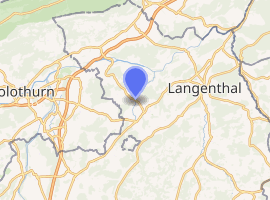Wanzwil
Wanzwil is a municipality in the district of Wangen in the canton of Bern in Switzerland.
Wanzwil | |
|---|---|
 Coat of arms | |
Location of Wanzwil 
| |
 Wanzwil  Wanzwil | |
| Coordinates: 47°12′N 7°42′E | |
| Country | Switzerland |
| Canton | Bern |
| District | Wangen |
| Area | |
| • Total | 0.6 km2 (0.2 sq mi) |
| Elevation | 455 m (1,493 ft) |
| Population (December 2007) | |
| • Total | 208 |
| • Density | 350/km2 (900/sq mi) |
| Postal code | 3372 |
| SFOS number | 994 |
| Surrounded by | Heimenhausen, Herzogenbuchsee, Niederönz, Röthenbach bei Herzogenbuchsee |
| Website | www SFSO statistics |
On January 1, 2009, the municipalities of Wanzwil and Röthenbach bei Herzogenbuchsee became part of the municipality of Heimenhausen.[1]
Geography
Before the merger, Wanzwil has an area of 0.6 km2 (0.23 sq mi). Of this area, 58.7% is used for agricultural purposes, while 27% is forested. The rest of the land, (14.3%) is settled.[2]
Demographics
Before the merger, Wanzwil had a population (as of 2007) of 208, of which 6.3% are foreign nationals. Over the last 10 years the population has decreased at a rate of -13.3%. Most of the population (as of 2000) speaks German (86.3%), with Italian being second most common ( 5.8%) and Albanian being third ( 2.9%).
In the 2007 election the most popular party was the SVP which received 45.7% of the vote. The next three most popular parties were the FDP (15.3%), the SPS (14%) and the Green Party (10.3%).
The age distribution of the population (as of 2000) is children and teenagers (0–19 years old) make up 21.2% of the population, while adults (20–64 years old) make up 65.6% and seniors (over 64 years old) make up 13.3%. In Wanzwil about 70.7% of the population (between age 25-64) have completed either non-mandatory upper secondary education or additional higher education (either University or a Fachhochschule).
Wanzwil has an unemployment rate of 0.64%. As of 2005, there were 10 people employed in the primary economic sector and about 3 businesses involved in this sector. 12 people are employed in the secondary sector and there are 3 businesses in this sector. 8 people are employed in the tertiary sector, with 4 businesses in this sector.[2]
References
- BSG 152.01 BAG 08-59 Die Justizkommission des Grossen Rats des Kantons Bern (Justice Commission of the High Council of Canton Bern) decision of 29 April 2008. (in German) accessed 16 July 2009
- Swiss Federal Statistical Office accessed 22-Jul-2009